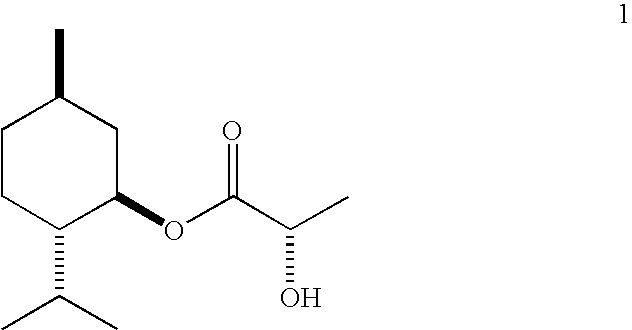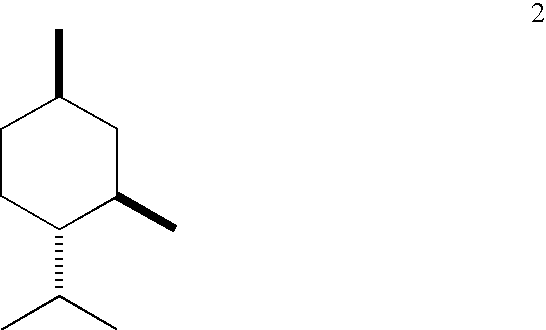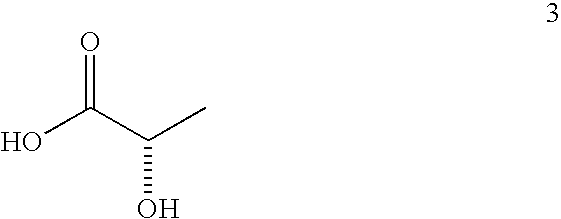Menthyl lactate process
a technology of menthyl lactate and process, which is applied in the preparation of carboxylic acid esters, chemistry apparatus and processes, and organic chemistry, etc., to achieve the effect of maximizing the overall yield of ml, simple practice, and minimizing the hydrolysis of menthyl lacta
- Summary
- Abstract
- Description
- Claims
- Application Information
AI Technical Summary
Benefits of technology
Problems solved by technology
Method used
Image
Examples
example 1
Preparation of l-Menthyl Lactate by Esterification and Controlled Hydrolysis
[0033]Esterification: A three-neck flask equipped with a Barrett trap, reflux condenser, thermocouple, heating mantle, and magnetic stirrer is charged with l-menthol (1440 g), L-(+)-lactic acid (2880 g of grade HS-88 from Purac, 88% lactic acid in water), and heptane (720 g). The stirred mixture is brought to reflux and water is periodically drained from the trap as it forms. The temperature of the mixture increases gradually to 128° C. after 32 h and after 854 mL of aqueous phase has been removed. The mixture is cooled to ambient temperature and analyzed by gas-liquid chromatography (GC). It contains: 5.4% of unreacted menthol, 67.7% of l-menthyl L-lactate (ML), 0.6% of lactide (cyclic dimer of lactic acid), 24.6% of l-menthyl L-lactoyl-L-lactate (MLL), and 0.4% of l-menthyl L-lactoyl-L-lactoyl-L-lactate (MLLL).
[0034]Controlled hydrolysis: The esterified product is diluted with water (4230 g) and heptane (9...
example 2
Preparation of l-Menthyl Lactate by Sulfuric Acid-Catalyzed Esterification and Controlled Hydrolysis
[0039]Esterification: The procedure of Example 1 is generally followed using 1000 g of l-menthol, 1000 g of L-(+)-lactic acid, 500 g of heptane, and 6 g of concentrated sulfuric acid. The temperature of the mixture increases gradually to 119° C. after 2 h and after 300 mL of aqueous phase has been removed. The mixture is cooled and analyzed by GC. It contains: 6.4% of unreacted menthol, 57.6% of ML, 0.4% of lactide, 32.2% of MLL, and 1.9% of MLLL.
[0040]Controlled hydrolysis: The esterified product is diluted with water (800 g) and heptane (500 mL). Aqueous sodium hydroxide (204 g of 50% NaOH) is then added dropwise over 70 min. while the mixture is stirred and cooled (cold water bath) so that the temperature does not exceed 30° C. and the pH does not exceed 13.1. The layers are separated. The organic layer is diluted with water (1350 g) and treated with more 50% aq. sodium hydroxide (...
example 3
Preparation of l-Menthyl Lactate by Sodium Bisulfate-Catalyzed Esterification
[0046]The esterification procedure of Example 1 is generally followed using 1000 g of l-menthol, 2000 g of L-(+)-lactic acid, 500 g of heptane, and 10 g of crystalline NaHSO4.H2O. The reflux starts at about 93° C. and finishes at about 123° C. after about 581 g of the water is drained, which takes slightly under 17 h. Composition of the mixture (%, GC): menthol 3.3%, ML 48.7%, lactide 4.8%, MLL 36.5%, MLLL 5.6%. The mixture is then used in the hydrolysis experiments described below.
PUM
| Property | Measurement | Unit |
|---|---|---|
| Temperature | aaaaa | aaaaa |
| Temperature | aaaaa | aaaaa |
| Temperature | aaaaa | aaaaa |
Abstract
Description
Claims
Application Information
 Login to View More
Login to View More - R&D
- Intellectual Property
- Life Sciences
- Materials
- Tech Scout
- Unparalleled Data Quality
- Higher Quality Content
- 60% Fewer Hallucinations
Browse by: Latest US Patents, China's latest patents, Technical Efficacy Thesaurus, Application Domain, Technology Topic, Popular Technical Reports.
© 2025 PatSnap. All rights reserved.Legal|Privacy policy|Modern Slavery Act Transparency Statement|Sitemap|About US| Contact US: help@patsnap.com



